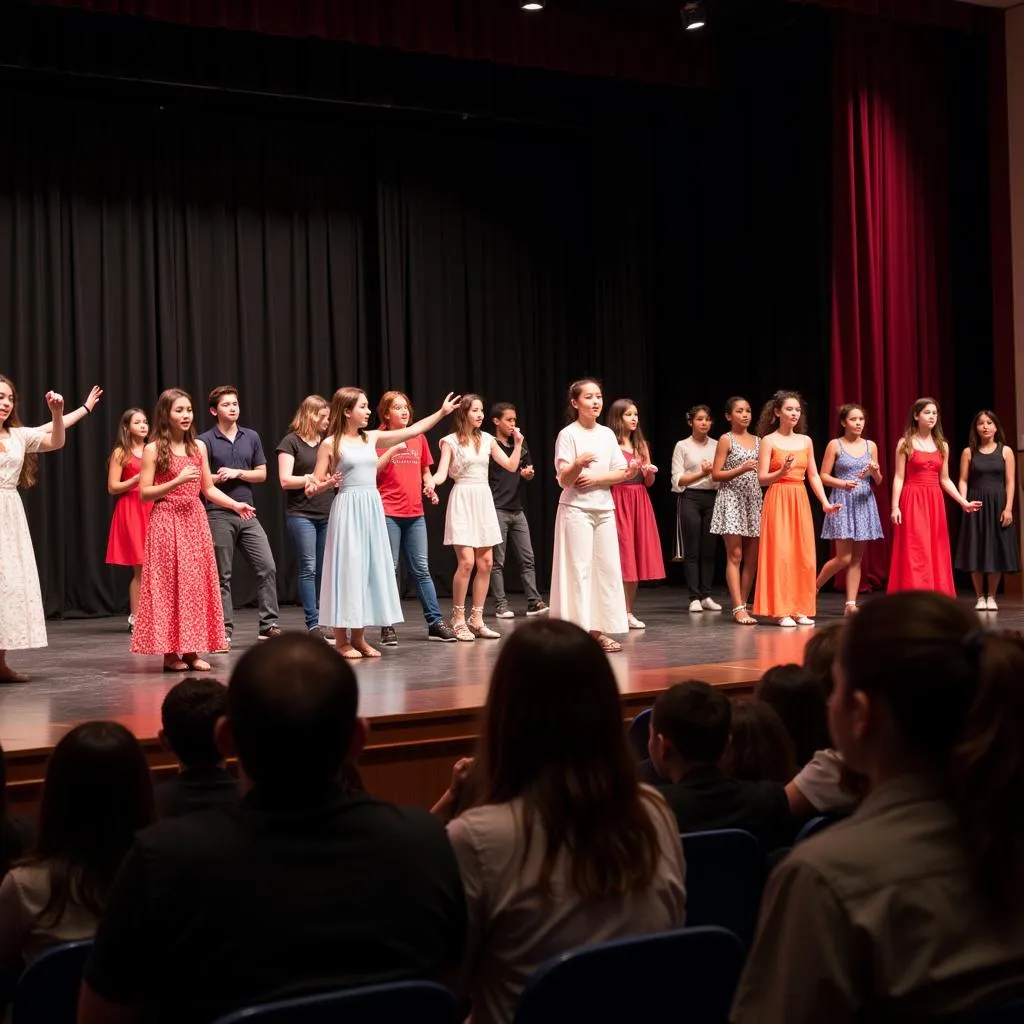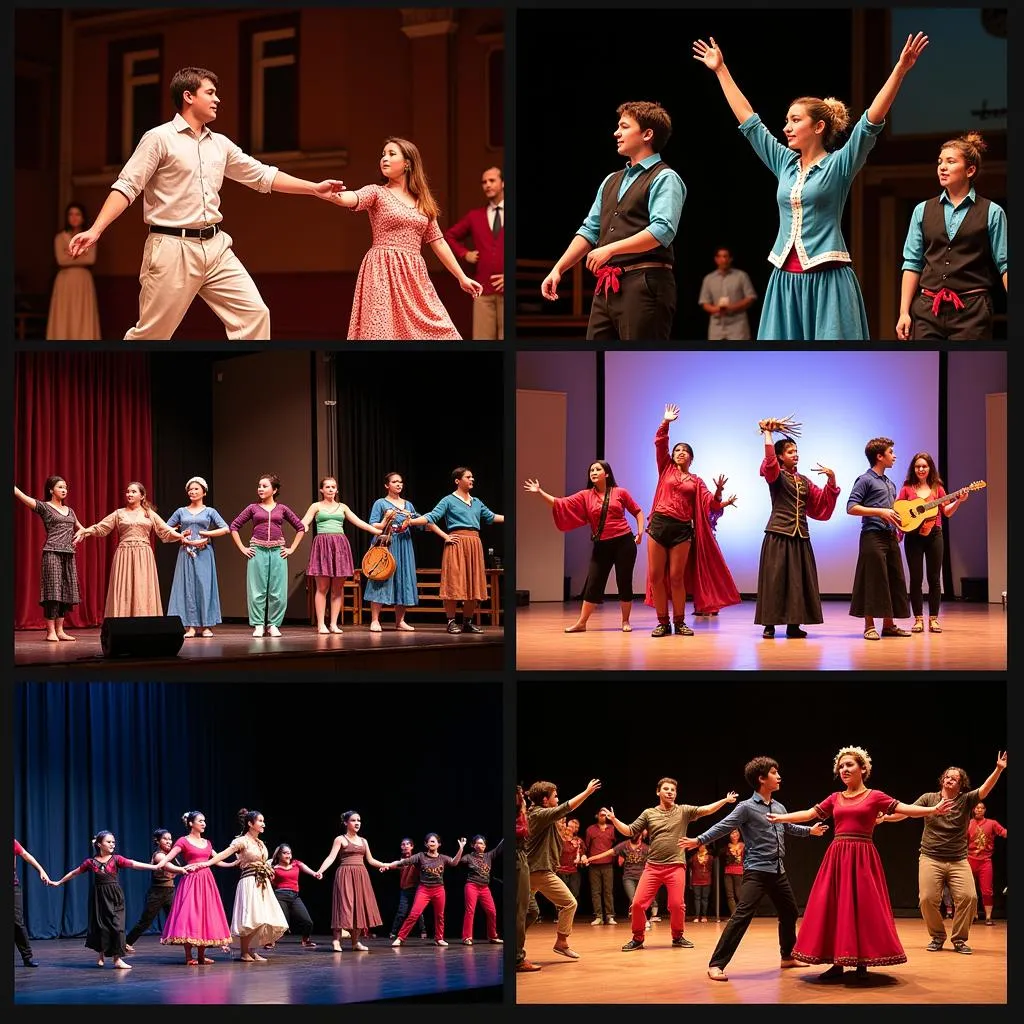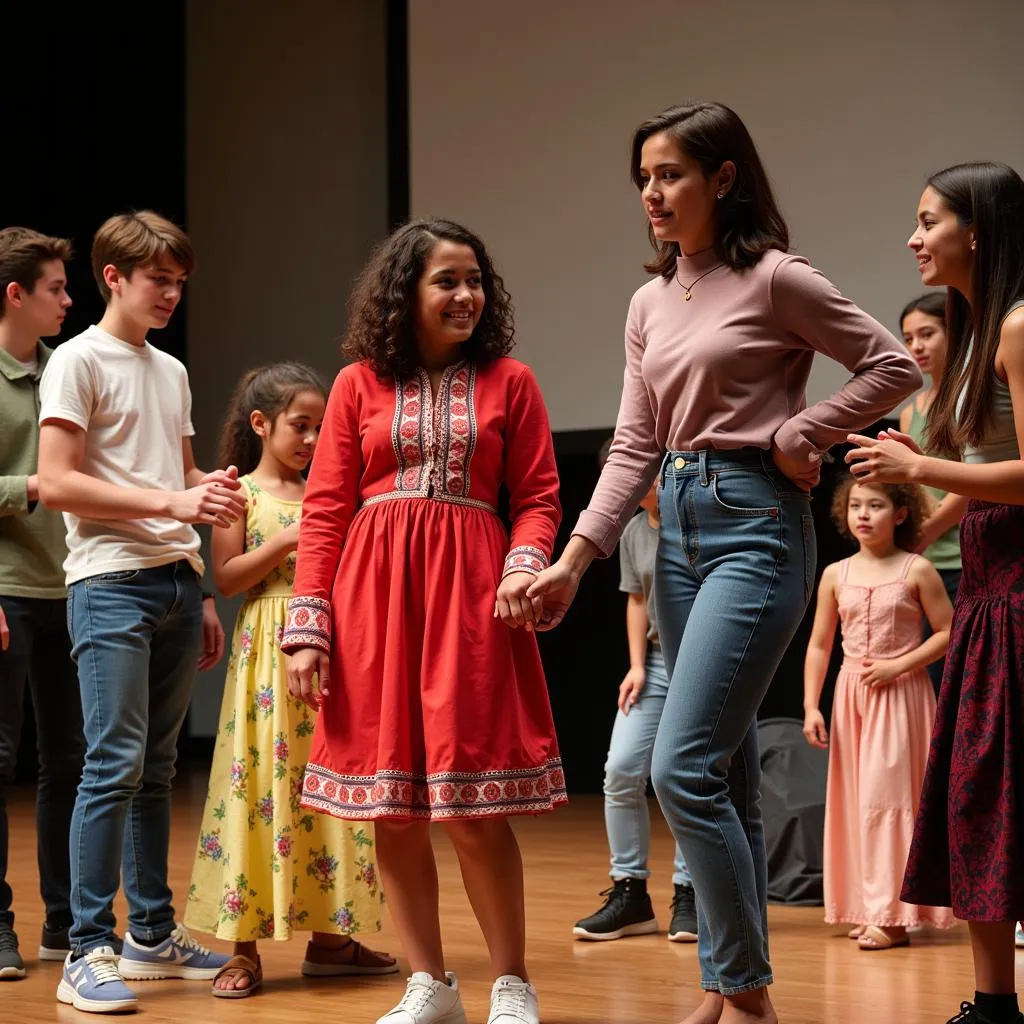The IELTS Reading test often includes passages on cultural topics, such as student performances and their impact on cultural exchange. Let’s explore this theme through a practice test that mimics the real IELTS exam structure, complete with questions and answers.
How cultural heritage days are celebrated in schools can provide valuable insights into the importance of student performances in cultural exchange. Now, let’s dive into our practice test.
Passage 1 – Easy Text
Student Performances: A Bridge Between Cultures
Student performances have long been recognized as a powerful tool for fostering cultural exchange and understanding. These events, ranging from music concerts to theatrical productions, provide a unique platform for young people to showcase their talents while simultaneously learning about and sharing different cultural traditions.
In many educational institutions, international festivals have become annual highlights, featuring performances that represent the diverse backgrounds of the student body. These festivals often include traditional dances, music recitals, and dramatic presentations that offer glimpses into various cultures. For instance, a Chinese student might perform a classical guzheng piece, while a student from Brazil might lead a samba dance routine.
The impact of these performances extends far beyond mere entertainment. They serve as a catalyst for cross-cultural dialogue, encouraging students to engage with and appreciate cultures different from their own. This exposure helps break down stereotypes and preconceptions, fostering a more inclusive and globally-minded student community.
Moreover, the preparation process for these performances often involves collaboration between students from different backgrounds. This teamwork naturally leads to cultural exchange, as students share their knowledge and experiences while working towards a common goal. It’s not uncommon for lasting friendships to form during this process, further enhancing the cultural exchange experience.
Educators have observed that student performances can also boost confidence and self-esteem, particularly among international students who might otherwise feel marginalized. By giving these students a platform to showcase their cultural heritage, schools create an environment of acceptance and celebration of diversity.
 Student performances bridging cultures
Student performances bridging cultures
Questions for Passage 1
Identifying Information (True/False/Not Given)
- Student performances only include music concerts.
- International festivals in schools feature performances from diverse cultural backgrounds.
- Student performances help in breaking down cultural stereotypes.
- All students are required to participate in cultural performances.
- Preparing for performances always leads to conflicts between students from different cultures.
Matching Headings
Match the following headings to the paragraphs in the passage. There are more headings than paragraphs, so you will not use all of them.
A. Types of student performances
B. Benefits of cultural exchange through performances
C. Challenges in organizing student performances
D. The role of educators in cultural performances
E. Impact on student confidence and self-esteem
F. Collaboration in preparation for performances
- Paragraph 2:
- Paragraph 3:
- Paragraph 4:
- Paragraph 5:
Short-answer Questions
Answer the following questions using NO MORE THAN THREE WORDS from the passage for each answer.
- What type of dialogue do student performances encourage?
- What do student performances help to break down?
- What can form between students during the preparation process for performances?
Passage 2 – Medium Text
The Evolution of Student Performances in Cultural Exchange Programs
The role of student performances in cultural exchange programs has undergone a significant transformation over the past few decades. What once began as simple showcases of traditional songs and dances has evolved into sophisticated, multifaceted events that blend various art forms and cultural elements. This evolution reflects the changing landscape of global education and the increasing importance of intercultural competence in today’s interconnected world.
Historically, cultural exchange programs often featured stereotypical representations of a country’s culture, focusing on well-known aspects that were easily recognizable to foreign audiences. However, contemporary approaches have shifted towards more nuanced and authentic portrayals of cultural identity. Modern student performances now strive to present a balanced view, incorporating both traditional and contemporary elements of a culture.
The influence of technology in student-led cultural events has been particularly transformative. Digital platforms and social media have enabled students to research and incorporate lesser-known aspects of their cultures into their performances. This has led to more diverse and inclusive representations, challenging audience preconceptions and fostering a deeper understanding of cultural complexities.
Furthermore, the collaborative nature of these performances has intensified. It’s now common to see fusion performances where students from different cultural backgrounds work together to create something entirely new. For example, a performance might combine Chinese calligraphy with modern dance, or blend African drumming with European classical music. These innovative approaches not only showcase individual cultures but also demonstrate the potential for harmonious cultural integration.
Educational institutions have recognized the pedagogical value of these evolved performances. Many schools now incorporate them into their curriculum, using them as a tool for teaching cultural literacy, empathy, and global citizenship. Students involved in these performances often report increased cultural awareness, improved communication skills, and a greater appreciation for diversity.
The impact of these evolved student performances extends beyond the educational setting. They often serve as a bridge between the school and the wider community, inviting local residents to experience and engage with diverse cultures. This community involvement helps to combat xenophobia and promotes social cohesion in increasingly multicultural societies.
 Evolution of student cultural performances
Evolution of student cultural performances
Questions for Passage 2
Multiple Choice
Choose the correct letter, A, B, C, or D.
-
According to the passage, student performances in cultural exchange programs have:
A) Remained unchanged over the years
B) Become less important in schools
C) Evolved to be more complex and diverse
D) Focused more on stereotypical representations -
Modern student performances aim to:
A) Only showcase traditional cultural elements
B) Present a balanced view of cultural identity
C) Avoid contemporary cultural aspects
D) Focus solely on well-known cultural aspects -
The role of technology in cultural performances has:
A) Decreased the authenticity of representations
B) Limited students’ access to cultural information
C) Enabled more diverse and inclusive representations
D) Reduced the need for live performances
Matching Sentence Endings
Match the beginnings of the sentences with the correct endings.
- Fusion performances
- Educational institutions
- Community involvement in these performances
- The pedagogical value of cultural performances
A. helps combat xenophobia in multicultural societies.
B. demonstrate the potential for cultural integration.
C. has been recognized and incorporated into curricula.
D. focuses only on traditional cultural elements.
E. increases cultural awareness and communication skills.
Summary Completion
Complete the summary below using words from the box. There are more words than spaces, so you will not use all of them.
stereotypical | nuanced | digital | fusion | traditional | modern | exclusive | inclusive
Cultural exchange performances have evolved from representations to more portrayals of cultural identity. The use of platforms has enabled students to incorporate lesser-known cultural aspects, leading to more representations. ___ performances, which combine elements from different cultures, showcase the potential for cultural integration and promote a deeper understanding of cultural complexities.
Passage 3 – Hard Text
The Transformative Power of Student Performances in Intercultural Learning
The paradigm shift in educational approaches to cultural exchange has positioned student performances at the forefront of intercultural learning. These performances, once perceived as mere entertainment, have metamorphosed into powerful pedagogical tools that facilitate profound cross-cultural understanding and personal growth. The multifaceted nature of these events engenders a complex interplay of cognitive, emotional, and social learning processes, culminating in a transformative experience for both performers and audience members alike.
At the crux of this transformation lies the concept of embodied learning. Unlike traditional, passive forms of cultural education, student performances require active participation and physical engagement. This kinesthetic approach to learning activates multiple sensory pathways, enhancing the retention and internalization of cultural knowledge. For instance, a student performing a traditional Japanese tea ceremony not only memorizes the steps but also internalizes the cultural values of mindfulness and respect embedded within the ritual.
Moreover, the preparation process for these performances necessitates deep dive into cultural contexts, historical backgrounds, and societal norms. This comprehensive research fosters critical thinking skills and encourages students to question their own cultural assumptions. The juxtaposition of different cultural elements within a single performance often leads to moments of cognitive dissonance, challenging students to reconcile conflicting worldviews and develop a more nuanced understanding of cultural relativism.
How music education fosters cross-cultural collaboration is evident in many of these performances, where students from diverse backgrounds come together to create harmonious productions. This collaborative process serves as a microcosm of intercultural communication, requiring students to navigate cultural differences, negotiate meanings, and find common ground. The skills developed during this process – empathy, adaptability, and cultural sensitivity – are invaluable in an increasingly globalized world.
The affective dimension of student performances cannot be overstated. The emotional engagement inherent in artistic expression allows for a deeper, more personal connection to cultural content. This emotional resonance can catalyze attitudinal changes towards other cultures, fostering openness and curiosity. Furthermore, the vulnerability required in performance can lead to increased empathy and mutual understanding among participants from different cultural backgrounds.
From a sociocultural perspective, these performances serve as a platform for negotiating and reconstructing cultural identities. Students engaged in representing their own cultures often experience a renewed sense of cultural pride and a deeper exploration of their heritage. Conversely, those portraying cultures other than their own gain insights that challenge stereotypes and promote intercultural empathy. This dynamic interplay between self-reflection and other-oriented understanding is at the heart of intercultural competence development.
The ripple effect of student performances extends far beyond the immediate participants. Audience members, including peers, educators, and community members, are exposed to diverse cultural expressions in an engaging, accessible format. This exposure can instigate dialogues about cultural diversity, social justice, and global citizenship, potentially leading to broader societal changes in attitudes towards multiculturalism and diversity.
 Transformative power of student performances in intercultural learning
Transformative power of student performances in intercultural learning
Questions for Passage 3
Matching Information
Match the following statements (A-H) with the correct paragraph (1-7). Write the correct letter, A-H, in boxes 1-7 on your answer sheet. NB You may use any letter more than once.
A. The impact of performances on audience members and the broader community
B. The importance of physical engagement in cultural learning
C. The role of emotions in deepening cultural understanding
D. The shift in perception of student performances in education
E. The development of critical thinking through cultural research
F. The collaborative nature of cross-cultural performances
G. The influence of performances on cultural identity formation
H. The long-term benefits of intercultural skills developed through performances
- Paragraph 1
- Paragraph 2
- Paragraph 3
- Paragraph 4
- Paragraph 5
- Paragraph 6
- Paragraph 7
Sentence Completion
Complete the sentences below using NO MORE THAN THREE WORDS from the passage for each answer.
- The concept of ___ is central to the transformative power of student performances in cultural learning.
- Preparing for performances requires students to conduct a ___ into various cultural aspects.
- The emotional engagement in performances can lead to ___ towards other cultures.
- Student performances serve as a platform for and cultural identities.
- The exposure to diverse cultural expressions through performances can instigate dialogues about ___ and global citizenship.
Multiple Choice
Choose the correct letter, A, B, C or D.
-
According to the passage, student performances in cultural exchange:
A) Are primarily for entertainment purposes
B) Have limited impact on cultural understanding
C) Facilitate profound cross-cultural understanding and personal growth
D) Are only effective for students from similar cultural backgrounds -
The process of preparing for cultural performances:
A) Only involves memorizing steps of traditional rituals
B) Encourages students to question their own cultural assumptions
C) Focuses solely on historical aspects of cultures
D) Avoids challenging students’ existing worldviews -
The collaborative process in cross-cultural performances:
A) Often leads to conflicts between students
B) Only benefits students from the dominant culture
C) Develops skills such as empathy and cultural sensitivity
D) Is not relevant in a globalized world
Answer Key
Passage 1
Identifying Information:
- False
- True
- True
- Not Given
- False
Matching Headings:
- Paragraph 2: A
- Paragraph 3: B
- Paragraph 4: F
- Paragraph 5: E
Short-answer Questions:
- cross-cultural dialogue
- stereotypes (and preconceptions)
- lasting friendships
Passage 2
Multiple Choice:
- C
- B
- C
Matching Sentence Endings:
- B
- C
- A
- E
Summary Completion:
stereotypical, nuanced, digital, inclusive, Fusion
Passage 3
Matching Information:
- D
- B
- E
- F
- C
- G
- A
Sentence Completion:
8. embodied learning
9. deep dive
10. attitudinal changes
11. negotiating, reconstructing
12. cultural diversity
Multiple Choice:
13. C
14. B
15. C
The role of dance in teaching cultural diversity is another aspect of student performances that contributes significantly to cultural exchange and understanding. These various forms of cultural expression, when incorporated into educational settings, create a rich tapestry of intercultural learning experiences.
In conclusion, student performances play a crucial role in cultural exchange, fostering understanding, and developing important intercultural skills. As the role of student-led initiatives in promoting cultural events continues to grow, we can expect to see even more innovative and impactful approaches to cultural education through performance in the future.
